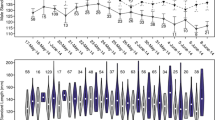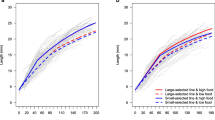Abstract
In a sex role reversed pipefish, Syngnathus typhle, we found that basic life history allocations were directly influenced by sexual selection. We investigated time allocation to foraging and mating, respectively, in a choice experiment, giving males and females, of small or large body size, a choice between food and a potential partner. We found that males were more interested in foraging than mating, i.e., were more frequently observed in front of the food than in front of the partner, whereas females were more interested in the potential partner. This reflects sexual selection operating differently on the two sexes, as males and females are relatively similar in other life history traits, such as growth, mortality, age of maturity, dispersal, and parental expenditure. Moreover, large individuals allocated more time to mating activities, small to feeding. Individuals more interested in mating compared to food were subsequently more critical when given a choice between a large (high-quality) and a small (low-quality) partner, whereas individuals more interested in food were not selective. These findings are consistent with our predictions: sex-role reversed males can be relatively sure of achieving one or more matings, and should allocate more time to feeding and, hence, to parental investment, growth and/or future reproduction. Females, on the other hand, have more uncertain mating prospects and should allocate time to imminent reproductive activities, thereby foregoing other life history traits such as growth and future egg production. By this, they also sacrifice future fecundity and attractiveness.


Similar content being viewed by others
References
Andersson MB (1994) Sexual selection. Sexual selection. Princeton Univ Press, Princeton, NJ
Badyaev AV (1997) Covariation between life history and sexually selected traits: an example with cardueline finches. Oikos 80:128–138
Berglund A (1991) Egg competition in a sex-role reversed pipefish: subdominant females trade reproduction for growth. Evolution 45:770–774
Berglund A (1999) Are female ornaments different from those of males? The pipefish evidence. In: Almada VC, Oliveira RF, Gonçalves EJ (eds) Behaviour and Conservation of Littoral Fishes. ISPA, Lisboa, pp 231–248
Berglund A (2000) Sex role reversal in a pipefish: female ornaments as amplifying handicaps. Ann Zool Fenn 37:1–13
Berglund A, Rosenqvist G (1990) Male limitation of female reproductive success in a pipefish: effects of body size differences. Behav Ecol Sociobiol 27:129–133
Berglund A, Rosenqvist G (1993) Selective males and ardent females in pipefishes. Behav Ecol Sociobiol 32:331–336
Berglund A, Rosenqvist G (2003) Sex role reversal in pipefish. Adv Study Behav 32:131–167
Berglund A, Rosenqvist G, Svensson I (1986a) Mate choice, fecundity and sexual dimorphism in two pipefish species (Syngnathidae). Behav Ecol Sociobiol 19:301–307
Berglund A, Rosenqvist G, Svensson I (1986b) Reversed sex roles and parental energy investment in zygotes of two pipefish (Syngnathidae) species. Mar Ecol Prog Ser 29:209–215
Berglund A, Rosenqvist G, Svensson I (1988) Multiple matings and paternal brood care in the pipefish Syngnathus typhle. Oikos 51:184–188
Berglund A, Rosenqvist G, Svensson I (1989) Reproductive success of females limited by males in two pipefish species. Am Nat 133:506–516
Berglund A, Rosenqvist G, Bernet P (1997) Ornamentation predicts reproductive success in female pipefish. Behav Ecol Sociobiol 40:145–150
Berglund A, Sandvik Widemo M, Rosenqvist G (2005) Sex role reversal revisited: choosy females and ornamented, competitive males in a pipefish. Behav Ecol 16:649–655
Bernet P, Rosenqvist G, Berglund A (1998) Female–female competition affects female ornamentation in the sex-role reversed pipefish Syngnathus typhle. Behaviour 135:535–550
Gotthard K, Nylin S, Wiklund C (2000) Mating opportunity and the evolution of sex-specific mortality rates in a butterfly. Oecologia 122:36–43
Heino M, Kaitala V (1999) Evolution of resource allocation between growth and reproduction in animals with indeterminate growth. J Evol Biol 12:423–429
Howard RD (1981) Sexual dimorphism in bull frogs Rana catesbeiana. Ecology 62:303–310
Howard RD, Kluge AG (1985) Proximate mechanisms of sexual selection in wood frogs. Evolution 39:260–277
Huse G (1998) Sex-specific life history strategies in capelin (Mallotus villosus)? Can J Fish Aquat Sci 55:631–638
Jones AG, Rosenqvist G, Berglund A, Avise JC (1999) The genetic mating system of a sex-role-reversed pipefish (Syngnathus typhle): a molecular inquiry. Behav Ecol Sociobiol 46:357–365
Jones AG, Rosenqvist G, Berglund A, Avise JC (2000) Mate quality influences multiple maternity in the sex-role-reversed pipefish Syngnathus typhle. Oikos 90:321–326
Kokko H (2001) Predicting the direction of sexual selection. Ecol Lett 4:159–165
Lika K, Kooijman SALM (2003) Life history implications of allocation to growth versus reproduction in dynamic energy budgets. Bull Math Biol 65:809–834
Mayer I, Rosenqvist G, Borg B, Ahnesjö A, Berglund A, Schulz RW (1993) Plasma levels of sex steroids in three species of pipefish (Syngnathidae). Can J Zool 71:1903–1907
Siems DP, Sikes RS (1998) Tradeoffs between growth and reproduction in response to temporal variation in food supply. Environ Biol Fishes 53:319–329
Slater PJB, Mann NI (2004) Why do the females of many bird species sing in the tropics? J Avian Biol 35:289–294
Stearns S (1992) The evolution of life-histories. Oxford UnivPress, Oxford, UK
Svensson I (1988) Reproductive costs in two sex role reversed pipefish species (Syngnathidae). J Anim Ecol 57:929–942
Troedsson C, Bouquet JM, Aksnes DL, Thompson EM (2002) Resource allocation between somatic growth and reproductive output in the pelagic chordate Oikopleura dioica allows opportunistic response to nutritional variation. Mar Ecol Prog Ser 243:83–91
Vincent A, Ahnesjö I, Berglund A (1994) Operational sex ratios and behavioural sex differences in a pipefish population. Behav Ecol Sociobiol 34:435–442
Vincent A, Berglund A, Ahnesjö I (1995) Reproductive ecology of five pipefish species in one eelgrass meadow. Environ Biol Fishes 44:347–361
Wimmer B, Kappeler PM (2002) The effects of sexual selection and life history on the genetic structure of redfronted lemur, Eulemur fulvus rufus, groups. Anim Behav 64:557–568
Acknowledgements
We thank Elias Berglund, Emma Berglund, and Ronny Höglund for their valuable assistance in the field and lab. Thanks to Ingrid Ahnesjö, Anna Qvarnström, and two anonymous referees for their valuable comments on the manuscript. The work was funded by grants to A. B. from the Swedish Research Council, to G. R. from the Norwegian Research Council and to S. R. W. from Uppsala University and the Swedish Royal Academy of Science. Thanks to Kristineberg Marine Research Station for the research facilities. The experiments reported in this study comply with the Swedish laws.
Author information
Authors and Affiliations
Corresponding author
Additional information
Communicated by C. St. Mary
Rights and permissions
About this article
Cite this article
Berglund, A., Rosenqvist, G. & Robinson-Wolrath, S. Food or sex—males and females in a sex role reversed pipefish have different interests. Behav Ecol Sociobiol 60, 281–287 (2006). https://doi.org/10.1007/s00265-006-0166-4
Received:
Revised:
Accepted:
Published:
Issue Date:
DOI: https://doi.org/10.1007/s00265-006-0166-4




